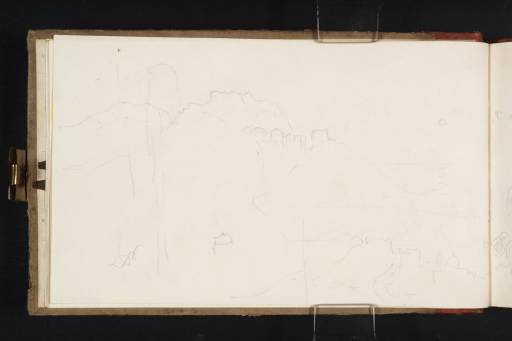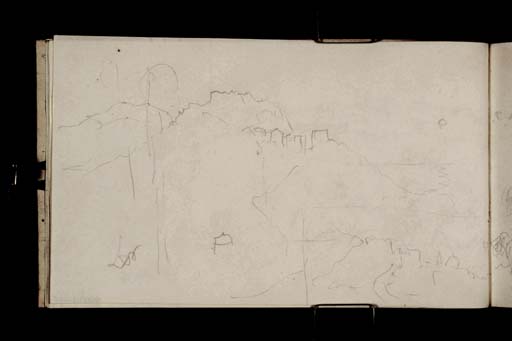Joseph Mallord William Turner ?Two Views of Loreto 1819
Image 1 of 2
Joseph Mallord William Turner,
?Two Views of Loreto
1819
Joseph Mallord William Turner 1775–1851
Folio 5 Verso:
?Two Views of Loreto 1819
D14662
Turner Bequest CLXXVII 5 a
Turner Bequest CLXXVII 5 a
Pencil on white wove paper, 110 x 186 mm
Inscribed by the artist in pencil ‘Lor’ bottom left
Inscribed by the artist in pencil ‘Lor’ bottom left
Accepted by the nation as part of the Turner Bequest 1856
Exhibition history
2000
Pure as Italian Air: Turner and Claude Lorrain, Tate Britain, London, November 2000–April 2001 (no catalogue).
2002
Turner et le Lorrain, Musée des beaux-arts, Nancy, December 2002–March 2003 (40, reproduced in colour).
References
1909
A.J. Finberg, A Complete Inventory of the Drawings of the Turner Bequest, London 1909, vol.I, p.520 as ‘Buildings on hill. “Lor” (probably Loreto)’.
1982
Evelyn Joll and Martin Butlin, L’opera completa di Turner 1793–1829, Classici dell’arte, Milan 1982, p.[120] under no.331.
1984
Martin Butlin and Evelyn Joll, The Paintings of J.M.W. Turner, revised ed., New Haven and London 1984, p.185 under no.331.
1984
Cecilia Powell, ‘Turner on Classic Ground: His Visits to Central and Southern Italy and Related Paintings and Drawings’, unpublished Ph.D thesis, Courtauld Institute of Art, University of London 1984, p.407, as ‘Includes (bottom right) the church at Campocavallo (between Osimo and Loreto).
2002
Ian Warrell, Blandine Chavanne and Michael Kitson, Turner et le Lorrain, exhibition catalogue, Musée des beaux-arts, Nancy 2002, no.40, pp.94 reproduced, 191, as ‘ “The first bit of Claude”; a view of Osimo on the road from Ancona (with views of Loreto and Campocavallo on the left-hand page)’.
After a sustained period of travel along the east coast from Rimini, Turner’s route towards Rome turned inland at Ancona and began to follow a south-westerly course towards the Apennine Mountains. Many of the urban settlements in this part of Italy were built upon high ground and Turner made a number of sketches of the hilltop towns and cities he glimpsed as he travelled through the landscape of the Marche region of Italy. The order of these drawings within the beginning of this sketchbook does not appear to follow a strict geographical sequence.
The subject of these two sketches has not been conclusively identified, although Turner’s inscription ‘Lor’ indicates that they may represent distant views of the town of Loreto. The right-hand side of the larger drawing appears to show the horizon of the Adriatic Sea. The low position of the sun with the light reflected on the water below suggests that Turner is sketching early in the morning with the sun rising in the east.
Cecilia Powell has suggested that the sketch in the bottom right-hand corner of the page depicts the dome and campanile of the Santuario di Campocavallo, a large church which lies a couple of miles south-east of Osimo.1 This is in fact impossible since the building dates from 1892–1905. It is likely instead that this is a distant view of the basilica of the Santuario della Santa Casa at Loreto, see folio 13 (D14677).
Nicola Moorby
November 2008
How to cite
Nicola Moorby, ‘?Two Views of Loreto 1819 by Joseph Mallord William Turner’, catalogue entry, November 2008, in David Blayney Brown (ed.), J.M.W. Turner: Sketchbooks, Drawings and Watercolours, Tate Research Publication, December 2012, https://www


